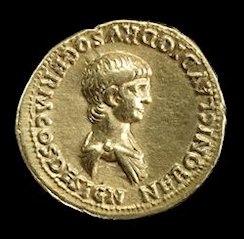
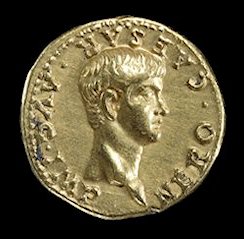
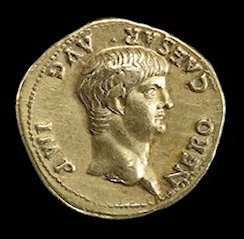
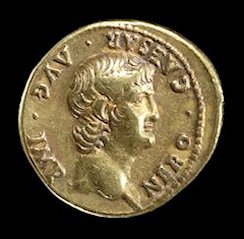
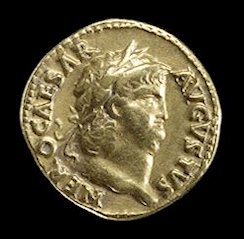
Statue 55 is, as has already been noted, when removed from the overtly distracting nature of the 18th century 'restoration', clearly a product of the earlier half of the first century AD, the coiffure in particular being distinctly Julio-Claudian in form. What is not clear, on first examination, is whether the portrait represents a member of the ruling first family of Rome or that of a private citizen. The portraiture of Roman men and women were, especially in the first and second centuries, very closely modelled upon replicas of the emperor and empress with regard to hairstyle, expression and pose (Fejfer 2008, 270-1). Private portraiture, where identified, may be closely related to the key trends in imperial iconography, such similarity in style often being referred to as the product of either 'Zeitgesicht' ('period-face': Zanker 1982) or 'Bildnisangleichnung' ('image assimilation': Massner 1982).
'Bildnisangleichnung' may be defined as the 'deliberate repetition of iconic formal or physiognomic details' (Fejfer 2008, 271-2) within portraiture created for members of the imperial court so as to evoke and refine an overall sense of kinship (Massner 1982). Such repetition can at times make it difficult to see who, precisely, is being depicted within replicas of marble and bronze, this presumably being a deliberate act in order to secure and reinforce a sense of dynastic succession (Fejfer 2008, 272). The 'Zeitgesicht', or 'period-face', in contrast, refers to the 'relationship between the portrait of the emperor and images of the men he ruled' (Fejfer 2008, 273) in which private portraits copied the stylistic options of the ruling elite, the degree of similarity being subject to the individual taste and aspirations of the buyer (Zanker 1982, 311). Although the impact of the 'period-face' in private portraiture was strong, especially in the early imperial period, individual commissions always differed in certain key areas from that of the imperial replica being copied. For this reason, both major and minor details of physiognomy and coiffure 'always set the portrait of the emperor apart from images of private people' (Fejfer 2008, 279), the individual commission being similar but never identical to the imperial image it set out to mimic.





With regard to Statue 55 from Petworth, the surviving areas of original physiognomy and coiffure demonstrate a very clear affinity with the known youthful portraits of the fifth princeps and last of the Julio-Claudian elite, Nero. The changing sequence of Nero's official portraiture, from the time of his formal adoption by Claudius in AD50 to his suicide in AD68, has been well documented, Ulrich Hiesinger establishing a chronological sequence, on the basis of coin evidence, of four distinctive models (classified as types I, III, IV and V) and a further probable, if briefly used, example (type II), charting Nero's development through three major hairstyles (Figure 4: Hiesinger 1975; Kleiner 1992, 135-9; Varner 2000, 126-30; 2004: 47-9). Each of the five types appears to have been created in order to celebrate an important event in Nero's fourteen-year reign and the years immediately preceding it, charting his rise from youthful prince to mature, and corpulent princeps. The first, rather sober Julio-Claudian coiffure, can be seen in the so-called 'Heir Apparent' and 'Accession' types, dated to AD51-54, AD54 and AD55-59 respectively (Hiesinger 1975, 113-14), while more complex coiffures, combined with increasingly fleshy features, can be observed in coin portraits commemorating his fifth and tenth anniversaries in power (AD59 and 64: Hiesinger 1975, 119-20).
Correlating Hiesinger's five-stages of coin portraiture with the sculptured replicas of Nero has not always proved an easy task. Partly this is because, as Hiesinger himself notes, the appearance of a discrete type on the coinage 'does not necessarily prove that its sculptured model also originated at the same moment' (Hiesinger 1975, 118). Difficulties in precise identification and comparison also arise because, unlike the coinage, sculptured replicas in marble and bronze underwent a degree of post-mortem memory sanctions following Nero's death, many images being defaced, vandalised, mutilated or simply refashioned (Pollini 1984; Born and Stemmer 1996, 101-7; Varner 2004, 49-78). Sufficient, albeit frequently partial, examples of Nero's physiognomy have, however, been recovered archaeologically, allowing some degree of comparison between stone and coin.
The earliest of the plastic images, which Hiesinger has referred to as an 'Adoption Type' (Hiesinger 1975, 118) correspond closely with the first (type I) coiffure recorded on the coins, and seem to have been produced from before AD50. In these, Nero (aged between 12 and 13) is portrayed as a slender individual with a delicate, centrally parted coiffure of elongated, comma-shaped locks. His face is smooth and regular with a small, rounded chin, an aquiline nose, crisply defined lips and almond-shaped eyes. From AD55 until 59, the more mature and facially muscular replicas, classified by Hiesinger as an 'Accession Type', appear to correspond closely with coin type III.
Between the 'Adoption' and 'Accession' models lies a 'somewhat ambiguous category' of replica, corresponding, to some degree, with coin type II, which Hiesinger described as an 'Heir Apparent Type' (Hiesinger 1975, 118), marking Nero's transition from prince to princeps. It is perhaps these first state-sanctioned portraits, created between adoption and the years immediately following his accession (in October AD54), that are the least well known to a modern audience, generally more familiar with the fleshy-faced, ornately coiffured and bearded character recorded on later coins.

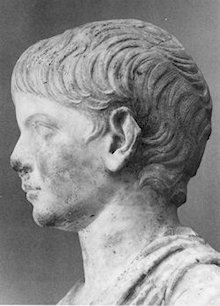


Four of the best-known examples of the teenage prince are preserved in the Museo Nazionale di Antichità, Parma, the Musée du Louvre, Paris (Figure 5), the Römisch-Germanisches Museum, Cologne and the Ny Carlsberg Glyptothek, Copenhagen (Figure 6: Hiesinger 1975, 118; Varner 2004, 48). These were all probably created in order to commemorate Nero's adoption and position as heir apparent, in place of Claudius' own biological son Britannicus. The statues preserved as full-figure portraits in the Museums of Parma and Paris (Figure 7) are set in broadly similar postures: a togate, bulla-wearing youth in declamatory pose, capsa by the left foot, facing an audience with (in the Paris example) arms slightly outstretched, holding a scroll in the left hand. Portraits such as these could have been swiftly disseminated throughout the empire, helping to emphasise both the true image of the heir-apparent and his inarguable legitimacy.
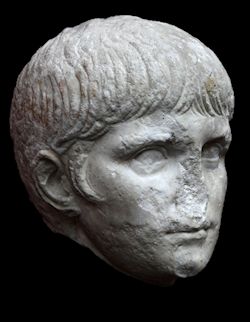

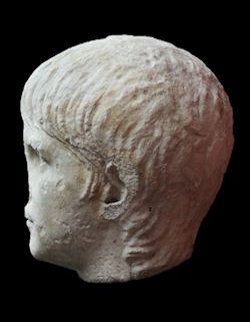
With both the modern restorations removed, it is clear that the Petworth statue has precisely the same distinctive physiognomic characteristics (especially in the cheeks, lips, chin and eyes) evident in the toga-wearing Nero on display in Parma and Paris, as well as the curving locks of hair and apparent central parting (Hiesinger 1975, 118; Kleiner 1992, 136; Varner 2004, 48). Even without the togate body, which (as noted above) may well have been intended for a different individual altogether, it is apparent that a near-identical match for Statue 55 may be found in images of the younger Nero, heir to the Emperor Claudius, created in or around AD51.
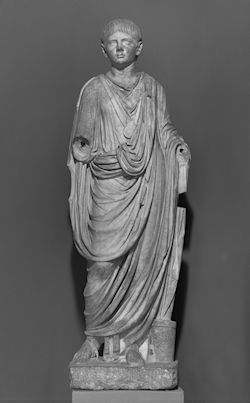
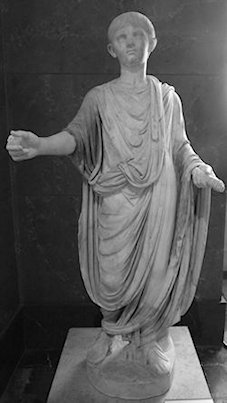
The levels of extreme violence to which the statue has been subjected, apparent decapitation and fragmentation of the face with an iron tool, may further support the identification with the fifth princeps, especially if the image had been subjected to memory sanctions in the months immediately following Nero's suicide and the civil war that came after. Portraits of the youthful Nero do not, however, appear to have been broadly affected by the more extreme forms of damnatio (Varner 2004, 67), possibly because such images were thought to relate to a more innocent version of the man, long before he was corrupted by power. Damage sustained to the Petworth statue, if related to memory sanctions, would therefore appear to be an exception to the rule. It has to be reiterated, however, that, in the absence of a full and frank record of 18th-century restoration, there can be no certainty that the areas of facial damage recorded across the portrait do not relate to more extreme forms of modern restoration.